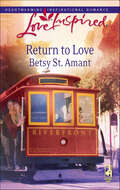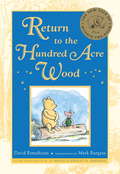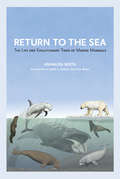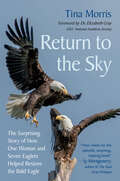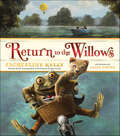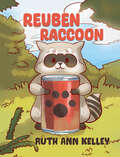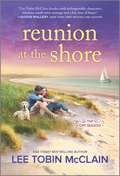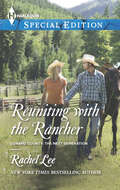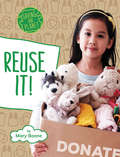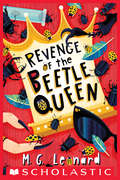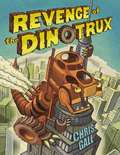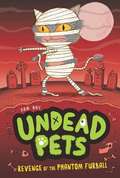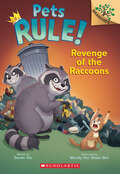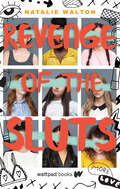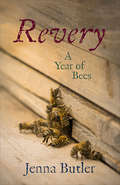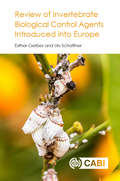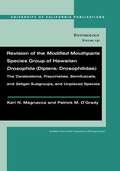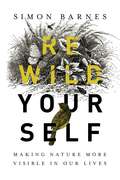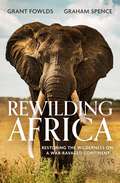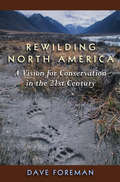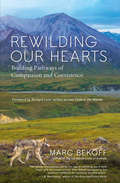- Table View
- List View
Return to Love
by Betsy St. Amant"I'm Not The Man I Used To Be!"If only Gracie Broussard could believe that! Years ago, Carter Alexander broke her heart and betrayed her. Now, just when she needs him most, he's back-asking her to believe he's changed. But this time, it's not just Gracie who'll be hurt if he disappears. A penguin keeper, Gracie urgently needs to find a new home for her beloved birds. Carter is the only one who can help. He promises that she can trust him, that he's not the rebel he once was. And that he needs Gracie as much as her birds do.
Return to the Hundred Acre Wood (Winnie-the-pooh Ser.)
by Mark Burgess David BenedictusVisit our all-new Pooh website!It was eighty years ago, on the publication of The House at Pooh Corner, when Christopher Robin said good-bye to Winnie-the-Pooh and his friends in the Hundred Acre Wood.<P><P> Now they are all back in new adventures, for the first time approved by the Trustees of the Pooh Properties. This is a companion volume that truly captures the style of A. A. Milne-a worthy sequel to The House at Pooh Corner and Winnie-the-Pooh.Listen to award-winning narrator Jim Dale reading the Exposition to Return to the Hundred Acre Wood. Also available from Penguin Audio.
Return to the Sea: The Life and Evolutionary Times of Marine Mammals
by Annalisa BertaReturn to the Sea portrays the life and evolutionary times of marine mammals--from giant whales and sea cows that originated 55 million years ago to the deep diving elephant seals and clam-eating walruses of modern times. This fascinating account of the origin of various marine mammal lineages, some extinct, others extant but threatened, is for the non-specialist. Set against a backdrop of geologic time, changing climates, and changing geography, evolution is the unifying principle that helps us to understand the present day diversity of marine mammals and their responses to environmental challenges. Annalisa Berta explains current controversies and explores patterns of change taking place today, such as shifting food webs and predator-prey relationships, habitat degradation, global warming, and the effects of humans on marine mammal communities.
Return to the Sky: The Surprising Story of How One Woman and Seven Eaglets Helped Restore the Bald Eagle
by Tina Morris&“Three cheers for this splendid, surprising, inspiring book!&”—Sy Montgomery, author of The Soul of an OctopusAlone in a vast wildlife refuge with little direction and no experience, a Cornell Laboratory of Ornithology student found herself responsible for a project of historical importance—to bring the Bald Eagle back from near extinction.In Return to the Sky, Tina Morris, one of the first women to engage in a raptor reintroduction program, shares her remarkable story that is as much about the human spirit as it is about birds of prey.In the spring of 1975, on the eve of the US Bicentennial, Tina was selected to reintroduce Bald Eagles into New York State in the hope that the species could eventually repopulate eastern North America. Young and female in a male-dominated field, Tina was handed an assignment to rehabilitate a population that had been devastated by the effects of DDT. The challenges were prodigious—there was no model to emulate for a bird of the eagle&’s size, for one—but Tina soon found that her own path to self-discovery and confidence-building was deeply connected with the survival of the species she was chosen to protect.Ultimately, Tina spent two years playing &“mother&” to seven eaglets at Montezuma National Wildlife Refuge, east of Seneca Falls in New York. Driven by her passion, she discovered unknown reserves of patience, determination, and grit.At a time when the mass extinction of bird species is a critical global topic, Return to the Sky reminds us how, with a mix of common sense, resilience, and resolve, humans can be effective stewards of the natural world.&“Inspiring . . . [and] proof that one determined person can still make a difference. At a time when the mass extinction of bird species is a critically important global topic, Dr Morris reminds us that humans can still be effective guardians of the natural world.&”—Forbes&“Emotional and inspiring proof that one person can make a difference.&”—Kirkus Reviews&“Inspiring . . . the writing is clear and eloquent . . . Morris expertly blends moving memoir and scientific research in this remarkable and affecting story.&”—Booklist
Return to the Willows
by Jacqueline KellyMole, Ratty, Toad, and Badger are back for more rollicking adventures in this sequel to The Wind in the Willows. With lavish illustrations by Clint Young, Jacqueline Kelly masterfully evokes the magic of Kenneth Grahame's beloved children's classic and brings it to life for a whole new generation. A riveting tale of bravery, bravado, and hot-air ballooning!
Reuben Raccoon
by Ruth Ann KelleyMeet Reuben Raccoon, the craftiest critter in the countryside! Every night, this determined raccoon steals more than just dog food – he steals the show with his clever antics! When Grandma Belle and Uncle Mark try to stop his midnight snack raids, Reuben won&’t be outsmarted. With a hungry family to feed, Reuben rolls up his sleeves (well, paws) and hatches a plan that will have you giggling. Will Grandma Belle ever win, or will Reuben&’s raccoon rascals outwit her every time?A delightful tale of mischief, teamwork, and never giving up when there&’s food on the line!
Reunion at the Shore (The Off Season #2)
by Lee Tobin McClainReturn to the Chesapeake Bay, where broken hearts find ways to heal.Ria and Drew Martin’s chemistry had always kept their marriage together—until suddenly it didn’t. Now a single mom, hotel manager Ria is at a loss when one of her teen daughters starts spiraling. Panicked, she calls on her estranged ex-husband for backup, but she’s not prepared for the man he’s become—or the unresolved emotions that still linger between them.After his divorce, Drew pulled away from everyone when he lost his eyesight and his job on the police force. Now that he’s realized how much his daughters need their dad, Drew is determined to make things up to them. He’s less sure where he stands with Ria. They had real reasons for ending their marriage, but they’ve both changed during their time apart. And being with her again in the place where they first fell in love brings back memories of all that they once had. Can they overcome their past to reunite their family, this time forever?
Reuniting with the Rancher: Her Wyoming Hero Reuniting With The Rancher (Conard County: The Next Generation #21)
by Rachel LeeA passionate summer romance between a rancher and a social worker is rekindled when they meet again unexpectedly in New York Times bestselling author Rachel Lee's latest addition to her miniseries, Conard County: The Next Generation! "I love you." Ten years ago rancher Cliff Martin said those three little words to Holly Heflin. But all she said was "goodbye." She ran from Conard County fast as a jackrabbit, leaving Cliff with a broken heart. But Cliff never forgot the one that got away.... Now Holly has returned to settle her aunt's estate-and Cliff is the executor. Her matchmaking aunt and his jealous ex-wife are the least of Holly's problems. Everywhere there are memories...and Cliff. But he's still a small-town rancher with roots and she's a big-city girl with a ticket home. She's got two weeks to avoid the hunky cowboy.... But what if she can't?
Reuse It! (Saving Our Planet)
by Mary BooneIntroduces early readers to environmentalist concepts including single-use plastics and upcycling, and what they can do to help the environment. Real-life examples of kids who have made a difference are featured.
Revenge of the Beetle Queen (Battle of the Beetles #2)
by M. G. Leonard“Rich in quirky humour,” the sequel to the bestselling Beetle Boy is a thrilling adventure story as kids battle a villainess well-versed in animal cruelty (The Guardian).Ruthless beetle fashionista, Lucretia Cutter, is at large with her deadly yellow ladybug spies—and she has a devious plan. When Darkus, Virginia, and Bertolt discover further evidence of her evil, they’re determined to stop her. But the three friends are in trouble. Darkus’s dad has forbidden them to investigate any further—and disgusting crooks Humphrey and Pickering are out of prison. Hope rests on Novak, Lucretia’s daughter and a Hollywood actress, but the beetle villainess is always one scuttle ahead . . . Beetles are back in an even-more-thrilling, chilling, and darkly funny sequel that will have readers clamoring for more.“A cracking tale for boys, girls—and grown ups.” —The Sun
Revenge of the Dinotrux
by Chris GallEveryone's favorite part-dino, part-truck monsters are back in this sequel to Dinotrux!Includes Read-Aloud/Read-to-Me functionality where available.Book Description:Millions of years ago, DINOTRUX ruled the earth. But in the present day, people rule them! Their rusty fossils are trapped in a museum surround by screaming kids, and now they're ready to break out and let off some really old steam. DINOTRUX ARE ON THE LOOSE! Who will win the daring standoff between man and prehistoric beast? Find out in this rip-roaring sequel to Chris Gall's highly praised Dinotrux!
Revenge of the Phantom Furball #2
by Simon Cooper Sam HayDisaster strikes when Bonsai the pug chases Pickle the cat into the street, where she is flattened by a car. But the fact that Pickle has (almost) shuffled off her mortal coil isn't her biggest concern; she is worried that Bonsai will pursue her sister Pebble into an early grave too, unless she and Joe teach the dog a lesson...
Revenge of the Raccoons: A Branches Book (Pets Rule!)
by Susan TanEmber and the other pets come face-to-face with two evil raccoons who are hungry for revenge and have a plan to sabotage the neighborhood!Pick a book. Grow a Reader!This series is part of Scholastic's early chapter book line, Branches, aimed at newly independent readers. With easy-to-read text, high-interest content, fast-paced plots, and illustrations on every page, these books will boost reading confidence and stamina. Branches books help readers grow! Ember comes face-to-face with evil twin sister raccoons who are looking for trouble! Will Ember and the other pets be able to stop the raccoons from plotting revenge against the entire neighborhood? With laugh-out-loud humor, engaging artwork on every page, and nonstop action that will have readers rushing to turn the pages, Pets Rule! is the just-right series for any emerging reader!
Revenge of the Sluts
by Natalie WaltonDouble standards are about to get singled out.In this stunning debut, author Natalie Walton tackles privacy and relationships in the digital age.As lead reporter for The Warrior Weekly, Eden has covered her fair share of stories at St. Joseph Secondary. And when intimate pictures of six female students are anonymously emailed to the entire school, Eden is determined to get to the bottom of it.In tracking down leads, Eden is shocked to discover not everyone agrees the students are victims. Some people feel the girls "brought it on themselves." Even worse, the school’s administration seems more concerned about protecting its reputation than its students.With the anonymous sender threatening more emails, Eden finds an unlikely ally: the six young women themselves. Banding together to find the perpetrator, the tables are about to be turned. The Slut Squad is fighting back!
Revenge of the Whale: The True Story of the Whaleship Essex
by Nathaniel PhilbrickBased on his New York Times best-seller "In the Heart of the Sea", Nathaniel Philbrick recreates the amazing events of the ill-fated Essex through the sailors' own first-hand accounts, photos, maps, and artwork, and tells the tale of one of the great true-life adventure stories.
Revery: A Year of Bees
by Jenna ButlerI hope you're okay in there, lovelies. I hope you're warm. After five years of working with bees on her farm in northern Alberta, Jenna Butler shares with the reader the rich experience of keeping hives. Starting with a rare bright day in late November as the bees are settling in for winter she takes us through a year in beekeeping on her small piece of the boreal forest. Weaving together her personal story with the practical aspects of running a farm, she takes us into the worlds of honeybees and wild bees. She considers the twinned development of the canola and honey industries in Alberta and the impact of crop sprays, debates the impact of introduced flowers versus native flowers, the effect of colony collapse disorder, and the protection of natural environments for wild bees. This is also the story of women and bees, and how beekeeping became Jenna Butler's personal survival story.
Review of Invertebrate Biological Control Agents Introduced into Europe
by Esther Gerber Urs SchaffnerAn overview of all documented releases of exotic invertebrate biological control agents (IBCAs) into Europe, the book summarizes key information on 176 IBCAs released against 58 target pests, and includes a summary chapter on releases in Europe over the past 110 years. The information is largely based on the BIOCAT database, originally developed by the late D. J. Greathead (former director of the International Institute of Biological Control, now part of CABI) and updated by CABI scientists.
Reviews of Physiology, Biochemistry and Pharmacology (Reviews of Physiology, Biochemistry and Pharmacology #184)
by Stine Helene Falsig PedersenLeading researchers are specially invited to provide a complete understanding of a key topic within the multidisciplinary fields of physiology, biochemistry and pharmacology. In a form immediately useful to scientists, this periodical aims to filter, highlight and review the latest developments in these rapidly advancing fields.
Revision of the Modified Mouthparts Species Group of Hawaiian Drosophila (Diptera: Drosophilidae)
by Karl N. Magnacca Patrick M. O'GradyThe modified mouthparts group is perhaps the largest of the four major Hawaiian Drosophila clades, yet has received relatively little taxonomic attention during the past 40 years. This study reviews unplaced species and the ceratostoma, freycinetiae, semifuscata, and setiger subgroups, with descriptions of 22 new species. We hope this work encourages greater study of the biology of this important group.
Rewild Yourself: Making Nature More Visible In Our Lives
by Simon BarnesFor those readers who want to get closer to the nature all around them and bring it back into focus within their lives, this book is the ideal companion. We're not just losing the wild world. We're forgetting it. We're no longer noticing it. We've lost the habit of looking and seeing and listening and hearing. But we can make hidden things visible, and this book features numerous spellbinding ways to bring the magic of nature much closer to home. Mammals you never knew existed will enter your world. Birds hidden in treetops will shed their cloak of anonymity. With a single movement of your hand you can make reptiles appear before you. Butterflies you never saw before will bring joy to every sunny day. Creatures of the darkness will enter your consciousness. And as you take on new techniques and a little new equipment, you will discover new creatures and, with them, new areas of yourself that had gone dormant. Once put to use, they wake up and start working again. You become wilder in your mind and in your heart. Once you know the tricks, the wild world begins to appear before you.
Rewilding Africa: Restoring the Wilderness on a War-ravaged Continent
by Graham Spence Grant FowldsConservationist Grant Fowlds lives to save and protect Africa's rhinos, elephants and other iconic wildlife, to preserve their habitats, to increase their range and bring back the animals where they have been decimated by decades of war, as in Angola, Mozambique and the Democratic Republic of the Congo. This vivid account of his work tells of a fellow conservationist tragically killed by the elephants he was seeking to save and a face-off with poachers, impoverished rural people exploited by rapacious local businessmen. Fowlds describes the impact of the Covid pandemic on conservation efforts, the vital wildlife tourism that sustains these and rural communities; and tells of conservationists' efforts to support people through the crisis. Lockdowns may have brought a welcome lull in rhino and other poaching, but also brought precious tourism to a standstill. He shows how the pandemic has highlighted the danger to the world of the illicit trade in endangered wildlife, some of it sold in 'wet markets', where pathogens incubate and spread. He describes a restoration project of apartheid-era, ex-South African soldiers seeking to make reparations in Angola, engulfed for many years in a profoundly damaging civil war, which drew in outside forces, from Cuba, Russia and South Africa, with a catastophic impact on that country's wildlife. Those who fund conservation, whether in the US, Zambia or South Africa itself, are of vital importance to efforts to conserve and rewild: some supposed angel-investors turn out to be not what they had appeared, some are thwarted in their efforts, but others are open-hearted and generous in the extreme, which makes their sudden, unexpected death an even greater tragedy. A passionate desire to conserve nature has also brought conservationists previously active in far-off Venezuela to southern Africa. Fowlds describes fraught meetings to negotiate the coexistence of wildlife and rural communities. There are vivid accounts of the skilled and dangerous work of using helicopters to keep wildebeest, carrying disease, and cattle apart, and to keep elephants from damaging communal land and eating crops such as sugar cane. He tells of a project to restore Africa's previously vast herds of elephants, particularly the famed 'tuskers', with their unusually large tusks, once prized and hunted almost to extinction. The range expansion that this entails is key to enabling Africa's iconic wildlife to survive, to preserving its wilderness and, in turn, helping humankind to survive.There is a heartening look at conservation efforts in Mozambique, a country scarred by years of war, which are starting to bear fruit, though just as a new ISIS insurgency creates havoc in the north of the country. What will humanity's relationship with nature be post-pandemic? Will we have begun to learn that by conserving iconic wildlife and their habitats we help to preserve and restore precious pockets of wilderness, which are so vital not only the survival of wildlife, but to our own survival on our one precious planet.
Rewilding Africa: Restoring the Wilderness on a War-ravaged Continent
by Graham Spence Grant FowldsConservationist Grant Fowlds lives to save and protect Africa's rhinos, elephants and other iconic wildlife, to preserve their habitats, to increase their range and bring back the animals where they have been decimated by decades of war, as in Angola, Mozambique and the Democratic Republic of the Congo. This vivid account of his work tells of a fellow conservationist tragically killed by the elephants he was seeking to save and a face-off with poachers, impoverished rural people exploited by rapacious local businessmen. Fowlds describes the impact of the Covid pandemic on conservation efforts, the vital wildlife tourism that sustains these and rural communities; and tells of conservationists' efforts to support people through the crisis. Lockdowns may have brought a welcome lull in rhino and other poaching, but also brought precious tourism to a standstill. He shows how the pandemic has highlighted the danger to the world of the illicit trade in endangered wildlife, some of it sold in 'wet markets', where pathogens incubate and spread. He describes a restoration project of apartheid-era, ex-South African soldiers seeking to make reparations in Angola, engulfed for many years in a profoundly damaging civil war, which drew in outside forces, from Cuba, Russia and South Africa, with a catastophic impact on that country's wildlife. Those who fund conservation, whether in the US, Zambia or South Africa itself, are of vital importance to efforts to conserve and rewild: some supposed angel-investors turn out to be not what they had appeared, some are thwarted in their efforts, but others are open-hearted and generous in the extreme, which makes their sudden, unexpected death an even greater tragedy. A passionate desire to conserve nature has also brought conservationists previously active in far-off Venezuela to southern Africa. Fowlds describes fraught meetings to negotiate the coexistence of wildlife and rural communities. There are vivid accounts of the skilled and dangerous work of using helicopters to keep wildebeest, carrying disease, and cattle apart, and to keep elephants from damaging communal land and eating crops such as sugar cane. He tells of a project to restore Africa's previously vast herds of elephants, particularly the famed 'tuskers', with their unusually large tusks, once prized and hunted almost to extinction. The range expansion that this entails is key to enabling Africa's iconic wildlife to survive, to preserving its wilderness and, in turn, helping humankind to survive.There is a heartening look at conservation efforts in Mozambique, a country scarred by years of war, which are starting to bear fruit, though just as a new ISIS insurgency creates havoc in the north of the country. What will humanity's relationship with nature be post-pandemic? Will we have begun to learn that by conserving iconic wildlife and their habitats we help to preserve and restore precious pockets of wilderness, which are so vital not only the survival of wildlife, but to our own survival on our one precious planet.
Rewilding North America: A Vision For Conservation In The 21St Century
by Dave ForemanDave Foreman is one of North America's most creative and effective conservation leaders, an outspoken proponent of protecting and restoring the earth's wildness, and a visionary thinker. Over the past 30 years, he has helped set direction for some of our most influential conservation organizations, served as editor and publisher of key conservation journals, and shared with readers his unique style and outlook in widely acclaimed books including The Big Outside and Confessions of an Eco-Warrior.In Rewilding North America, Dave Foreman takes on arguably the biggest ecological threat of our time: the global extinction crisis. He not only explains the problem in clear and powerful terms, but also offers a bold, hopeful, scientifically credible, and practically achievable solution.Foreman begins by setting out the specific evidence that a mass extinction is happening and analyzes how humans are causing it. Adapting Aldo Leopold's idea of ecological wounds, he details human impacts on species survival in seven categories, including direct killing, habitat loss and fragmentation, exotic species, and climate change. Foreman describes recent discoveries in conservation biology that call for wildlands networks instead of isolated protected areas, and, reviewing the history of protected areas, shows how wildlands networks are a logical next step for the conservation movement. The final section describes specific approaches for designing such networks (based on the work of the Wildlands Project, an organization Foreman helped to found) and offers concrete and workable reforms for establishing them. The author closes with an inspiring and empowering call to action for scientists and activists alike.Rewilding North America offers both a vision and a strategy for reconnecting, restoring, and rewilding the North American continent, and is an essential guidebook for anyone concerned with the future of life on earth.
Rewilding Our Hearts: Building Pathways of Compassion and Coexistence
by Marc BekoffIn wildlife conservation, rewilding refers to restoring habitats and creating corridors between preserved lands to allow declining populations to rebound. Marc Bekoff, one of the world’s leading animal experts and activists, here applies rewilding to human attitudes. Rewilding Our Hearts invites readers to do the essential work of becoming reenchanted with the world, acting from the inside out, and dissolving false boundaries to truly connect with both nature and themselves.
Rex
by Stanley FrancisA fun story of a dinosaur playing joyfully in a garden with a playing chute, jumping rope etc.
